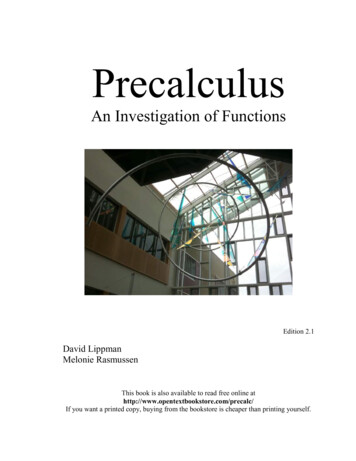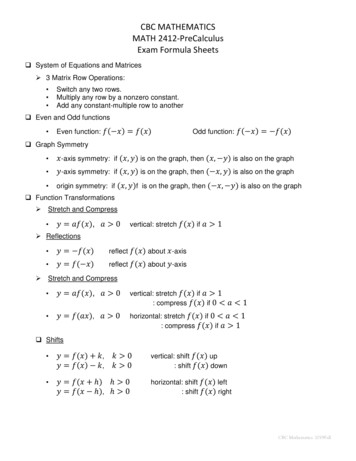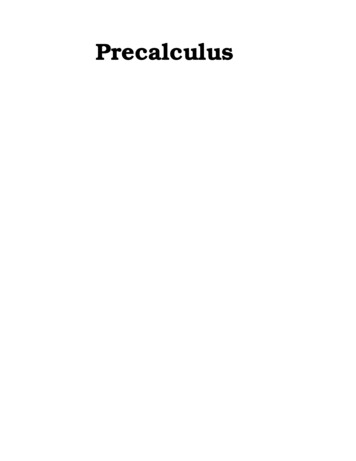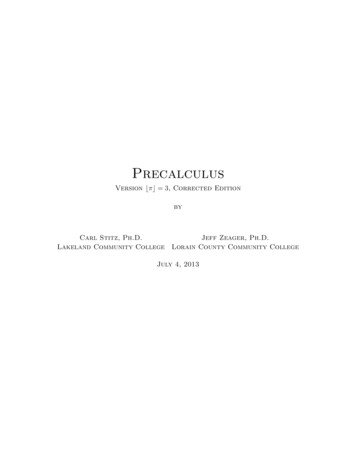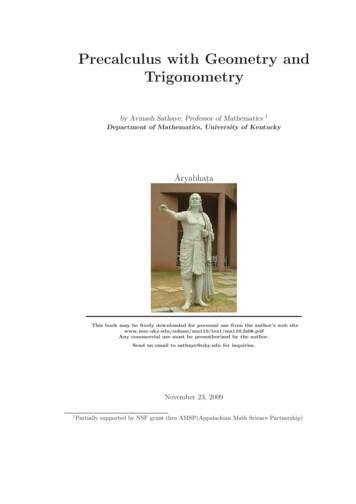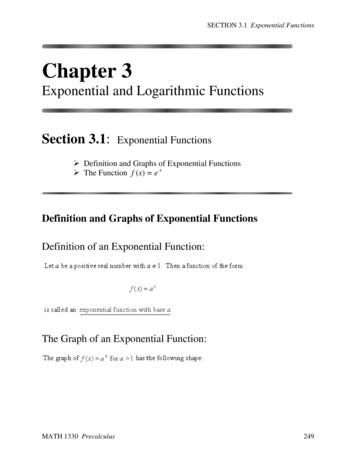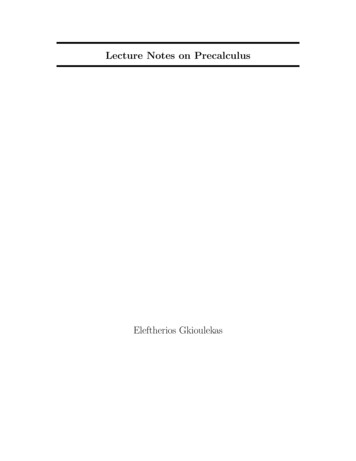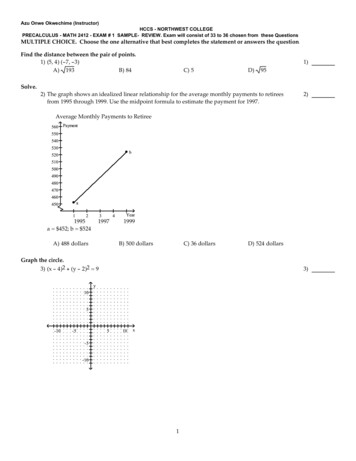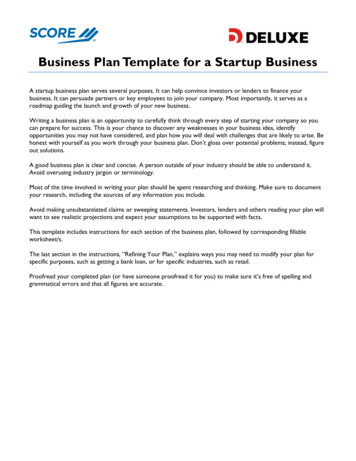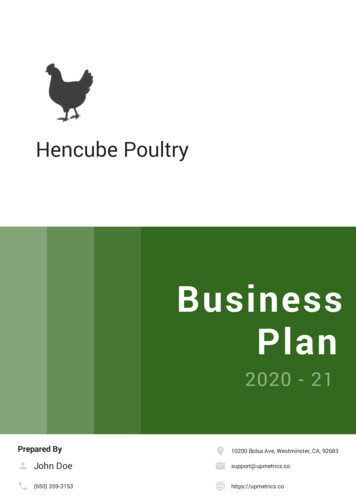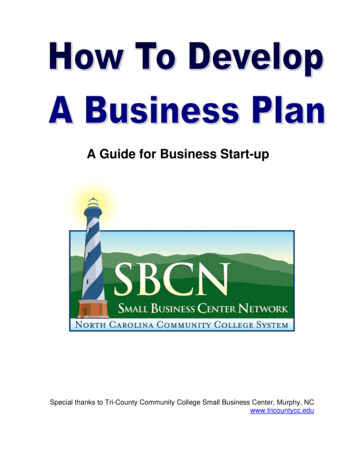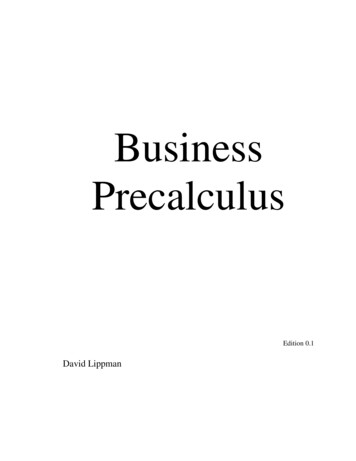
Transcription
BusinessPrecalculusEdition 0.1David Lippman
iiCopyright 2016 David LippmanThis text is licensed under a Creative Commons Attribution-Share Alike 3.0 UnitedStates License.To view a copy of this license, visit http://creativecommons.org/licenses/by-sa/3.0/us/ or send a letter toCreative Commons, 171 Second Street, Suite 300, San Francisco, California, 94105, USA.You are free:to Share — to copy, distribute, display, and perform the workto Remix — to make derivative worksUnder the following conditions:Attribution. You must attribute the work in the manner specified by the author or licensor (but not inany way that suggests that they endorse you or your use of the work).Share Alike. If you alter, transform, or build upon this work, you may distribute the resulting workonly under the same, similar or a compatible license.With the understanding that:Waiver. Any of the above conditions can be waived if you get permission from the copyright holder.Other Rights. In no way are any of the following rights affected by the license: Your fair dealing or fair use rights; Apart from the remix rights granted under this license, the author's moral rights; Rights other persons may have either in the work itself or in how the work is used, such aspublicity or privacy rights. Notice — For any reuse or distribution, you must make clear to others the license terms ofthis work. The best way to do this is with a link to this web /us/Chapters 1 – 3 are remixed from Precalculus: An Investigation of Functions, 2015David Lippman and Melonie Rasmussen, under the Creative Commons AttributionShare-Alike license.Chapter 4 is remixed from College Algebra, 2015 Rice University, produced byOpenStax College, under a Creative Commons Attribution license. Download the originalfor free at ter 5 contains portions remixed from My the Numbers, Milos Podmanik, underthe Creative Commons Attribution Non-Commercial Share-Alike license, and fromApplied Finite Math Rupinder Sekhon, under the Creative Commons Attributionlicense.Chapter 6 – 8 are remixed from Math in Society, 2015 David Lippman, under theCreative Commons Attribution Share-Alike license.
iiiAbout the AuthorDavid Lippman received his master’s degree in mathematicsfrom Western Washington University and has been teaching atPierce College since Fall 2000.David has been long time advocate of open learning, openmaterials, and basically any idea that will reduce the cost ofeducation for students. It started by supporting the college’scalculator rental program, and running a book loan scholarshipprogram. Eventually the frustration with the escalating costs ofcommercial text books and the online homework systems thatcharged for access led him and his colleagues to take action.First, David developed IMathAS, open source online math homework software that runsWAMAP.org and MyOpenMath.com. Through this platform, he became an integral partof a vibrant sharing and learning community of teachers from around Washington Statethat support and contribute to WAMAP. Those pioneering efforts, supported by dozensof other dedicated faculty and financial support from the Transition Math Project, led to asystem used by thousands of students every quarter, saving hundreds of thousands ofdollars over comparable commercial offerings.David continued further and wrote his first open textbook, Math in Society, a math forliberal arts majors book, after being frustrated by students having to pay 100 for atextbook for a terminal course. Frustrated by both cost and the style of commercial texts,David and colleague Melonie Rasmussen began writing PreCalculus: An Investigation ofFunctions in 2010.This text pulls in portions from Precalculus, Math in Society, and other open textbooks,and adapts them to have the business focus desired for a business precalculus or finitemath course. This text serves as preparation for Applied Calculus, a business-focusedbrief calculus text coauthored by Shana Calaway, Dale Hoffman, and David.SupplementsOnline homework and video lesson sets to accompany this text are available onMyOpenMath.com.
ivTable of ContentsChapter 1: Functions and Lines . 1Section 1.1 Functions and Function Notation . 1Section 1.2 Domain and Range. 10Section 1.3 Rates of Change and Behavior of Graphs . 19Section 1.4 Linear Functions . 27Section 1.5 Graphs of Linear Functions . 34Section 1.6 Modeling with Linear Functions. 45Section 1.7 Fitting Linear Models to Data . 53Chapter 2: Systems of Equations and Matrices . 59Section 2.1 Systems of Equations . 59Section 2.2 Solving Systems using Matrices . 76Section 2.3 Matrix Operations . 90Section 2.4 Solving Systems with Inverses . 101Chapter 3: Linear Programming . 115Section 3.1 Inequalities in One Variable . 115Section 3.2 Linear Inequalities . 125Section 3.3 Graphical Solutions. 131Section 3.4 Simplex Method . 140Section 3.5 Applications of Linear Programming . 146Chapter 4: Polynomial and Rational Functions. 153Section 4.1 Quadratic Functions . 153Section 4.2 Polynomial Functions . 164Section 4.3 Rational Functions . 175Chapter 5: Exponential and Logarithmic Functions. 185Section 5.1 Exponential Functions . 185Section 5.2 Logarithmic Functions . 199Section 5.3 Exponential and Logarithmic Models. 211Chapter 6: Finance . 221Section 6.1 Simple and Compound Interest. 221Section 6.2 Annuities . 230Section 6.3 Payout Annuities . 235Section 6.4 Loans . 239Section 6.5 Multistage Finance Problems. 246Chapter 7: Sets . 253Section 7.1 Sets . 253Section 7.2 Venn Diagrams and Cardinality . 258Chapter 8: Probability. 265Section 8.1 Concepts of Probability . 265Section 8.2 Conditional Probability and Bayes Theorem . 275Section 8.3 Counting. 283Section 8.4 Expected Value . 296
1Chapter 1: Functions and LinesSection 1.1 Functions and Function Notation . 1Section 1.2 Domain and Range . 10Section 1.3 Rates of Change and Behavior of Graphs . 19Section 1.4 Linear Functions . 27Section 1.5 Graphs of Linear Functions . 34Section 1.6 Modeling with Linear Functions . 45Section 1.7 Fitting Linear Models to Data . 53Section 1.1 Functions and Function NotationWhat is a Function?The natural world is full of relationships between quantities that change. When we seethese relationships, it is natural for us to ask “If I know one quantity, can I then determinethe other?” This establishes the idea of an input quantity, or independent variable, and acorresponding output quantity, or dependent variable. From this we get the notion of afunctional relationship in which the output can be determined from the input.For some quantities, like height and age, there are certainly relationships between thesequantities. Given a specific person and any age, it is easy enough to determine theirheight, but if we tried to reverse that relationship and determine age from a given height,that would be problematic, since most people maintain the same height for many years.FunctionFunction: A rule for a relationship between an input, or independent, quantity and anoutput, or dependent, quantity in which each input value uniquely determines oneoutput value. We say “the output is a function of the input.”Example 1In the height and age example above, is height a function of age? Is age a function ofheight?In the height and age example above, it would be correct to say that height is a functionof age, since each age uniquely determines a height. For example, on my 18th birthday,I had exactly one height of 69 inches.However, age is not a function of height, since one height input might correspond withmore than one output age. For example, for an input height of 70 inches, there is morethan one output of age since I was 70 inches at the age of 20 and 21.This chapter is part of Business Precalculus David Lippman 2016.This content is remixed from Precalculus: An Investigation of Functions Lippman & Rasmussen 2011.This material is licensed under a Creative Commons CC-BY-SA license.
2 Chapter 1Example 2At a coffee shop, the menu consists of items and their prices. Is price a function of theitem? Is the item a function of the price?We could say that price is a function of the item, since each input of an item has oneoutput of a price corresponding to it. We could not say that item is a function of price,since two items might have the same price.Example 3In many classes the overall percentage you earn in the course corresponds to a decimalgrade point. Is decimal grade a function of percentage? Is percentage a function ofdecimal grade?For any percentage earned, there would be a decimal grade associated, so we could saythat the decimal grade is a function of percentage. That is, if you input the percentage,your output would be a decimal grade. Percentage may or may not be a function ofdecimal grade, depending upon the teacher’s grading scheme. With some gradingsystems, there are a range of percentages that correspond to the same decimal grade.Try it NowLet’s consider bank account information.1. Is your balance a function of your bank account number?(if you input a bank account number does it make sense that the output is your balance?)2. Is your bank account number a function of your balance?(if you input a balance does it make sense that the output is your bank account number?)Function NotationTo simplify writing out expressions and equations involving functions, a simplifiednotation is often used. We also use descriptive variables to help us remember themeaning of the quantities in the problem.Rather than write “height is a function of age”, we could use the descriptive variable h torepresent height and we could use the descriptive variable a to represent age.“height is a function of age”“h is f of a”h f(a)h(a)if we name the function f we writeor more simplywe could instead name the function h and writewhich is read “h of a”Remember we can use any variable to name the function; the notation h(a) shows us thath depends on a. The value “a” must be put into the function “h” to get a result. Becareful - the parentheses indicate that age is input into the function (Note: do not confusethese parentheses with multiplication!).
Section 1.1 Functions and Function Notation3Function NotationThe notation output f(input) defines a function named f. This would be read “outputis f of input”Example 4Introduce fu
David continued further and wrote his first open textbook, Math in Society, a math for liberal arts majors book, after being frustrated by students having to pay 100 for a textbook for a terminal course. Frustrated by both cost and the style of commercial texts, David and colleague Melonie Rasmussen began writing PreCalculus: An Investigation of Functions in 2010. This text pulls in portions .
